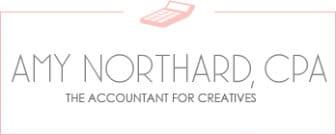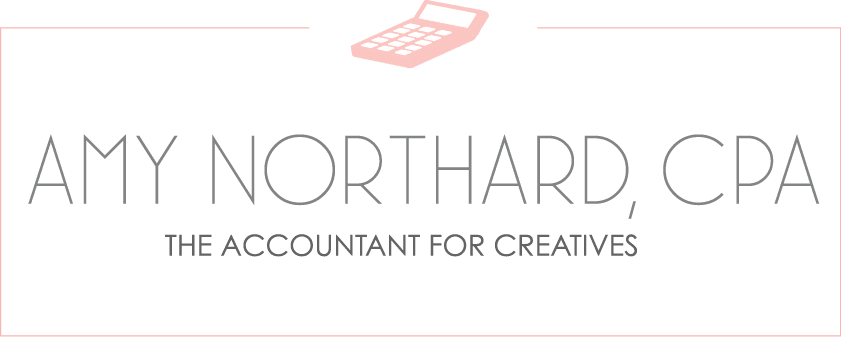The three things we’ll be going over today are creating a usable bookkeeping system, what some commonly forgotten tax deductions are, and an easy tax time checklist so you can make sure you’ve got everything you need or your accountant needs for your taxes.
Creating a useable bookkeeping system
Let’s start by going through the steps of creating a usable bookkeeping system. The term “usable” is really key here because if you aren’t using the system on a regular basis, it gets overwhelming and very easy to put off month after month.
I can speak from personal experience here. Just last year, I kept putting my own bookkeeping to the side to work with my clients on theirs. Every month bookkeeping felt like a daunting task because my expenses were spread out in PayPal, a personal checking account, a business checking account and my personal credit card. I knew I needed to simplify my process and stop using personal accounts for business expenses. I got that taken care of and then I started using Quickbooks for my bookkeeping instead of the manual process I was using before. I just keep up the Quickbooks Online window as one of the millions of tabs on my browser and click over to it every couple of days to see if any transactions need to be categorized. By doing this, all I have to do at the end of the month is reconcile my accounts and I’m good to go.
The first step of the process is to open a separate business bank account, then organize your receipts, choose a program to record your transactions, reconcile your accounts monthly and then time to analyze and celebrate!
Open a separate business bank account
If you don’t already have separate bank accounts for your business transactions, this is the first thing you need to do to create a usable bookkeeping system. It makes bookkeeping easier because you aren’t filtering through your day-to-day personal expenses trying to mark what’s business and what’s personal. You already know!
If your business is any structure other than a sole proprietorship, you must have separate accounts. To hold onto the protection that a Limited Liability Company or S-corporation offers, you must treat your business as a separate entity and avoid mixing business and personal expenses.
In addition to opening a business checking account, you may want to open a separate business savings account. I use this account to hold onto money for my quarterly taxes. This way it’s out of sight, out of mind and ready when I need to make a quarterly payment.
Organize receipts
The next step is to organize your receipts. There are so many ways you can do this, so if one method isn’t working for you, switch it up.
Just make sure you follow these two rules:
- The first rule: keep a copy of the receipt as a paper copy or a scanned electronic copy and remember: bank statements don’t count as a receipt.
- The second rule: keep receipts for at least 3 years. But, keep in mind that if there are substantial errors on your tax return, the IRS could audit you up to 6 years after you file your return.
For my paper receipts, I’ve labeled 12 envelopes with the months and I use those to stash receipts instead of letting them collect in my purse or get lost in my office. For electronic receipts, I save them to a folder in my email that I’ve labeled “receipts.” With this method, when I’m doing my bookkeeping, I always have two places to check for expenses: either my paper files or my emailed receipts. If you don’t like paper hanging around, you can always scan your receipts and then toss them. Just be careful that you have this information backed up and not stored in one place.
Choose a program to record transactions
Now that you’ve got an organizational system in place for your receipts, it’s time to choose an accounting program. If you don’t have a lot of transactions, you can usually get by using a spreadsheet to record your income and expenses. The downside to this is that it can be a lot of manual work and if it takes too much of your time, you won’t want to do it and then it will be something that gets procrastinated month after month.
If you’ve got more transactions than you’d like to manually type into a spreadsheet, I recommend you check out a cloud accounting program. There are so many to choose from. These are just a few of the ones my clients like to use. Most have a monthly fee and allow you to use their program for a trial period before paying so you can get a feel for what you like.
The nice thing about the cloud accounting programs is that they automatically pull the transactions that show up in your bank account, PayPal account, or several other types of accounts into the program. Then, all you have to do is assign categories to the transactions. Most programs also have a feature where they recognize expenses and assign the transaction a category for you. Then, all you have to do is review it to make sure it’s correct.
If a category you need isn’t listed in their pre-populated list of expense categories, you can always add what you need. Don’t be afraid to make up expense categories.
Reconcile accounts monthly
Now we’re at the second to last step, which is reconciling your accounts monthly.
Think of reconciling like balancing a checkbook. You’re making sure everything that’s showing up in your accounting program is matching what’s on your bank statement. If something doesn’t match, that’s a red flag to you that something was entered incorrectly, a transaction was entered twice, or maybe accidentally left out.
You’ll do this process for any business accounts you have linked to your accounting program.
Analyze and celebrate!
Now that you’ve completed bookkeeping in your new system for a month, it’s time to analyze and celebrate!
As part of your analysis, review your profit and loss statement. This will show you if you’ve made money or not. If you have, congratulations! Now you need to set aside some of that profit for taxes. I usually recommend 25-30% to cover Federal and State quarterly taxes.
This is also a good time to compare your current numbers to your budgeted numbers. Are you on track for your budgeted income?
The last and most fun item on this slide is to pay yourself. The amount and frequency you pay yourself will be different for everyone. Just keep in mind that if you’re a sole proprietor or single-member LLC, any income left after expenses are taxed, not just the money you transfer to your personal bank account.
Now, I just want to take a minute to talk to those people who already have a bookkeeping system in place and they’re ready to outsource. I think this is a great option for people who have done their own bookkeeping for a while and feel like they have a pretty good handle on what the numbers mean. They’ve reached a point where their time can be better spent working on other things within their business, but they still feel comfortable with the numbers side of their business.
Start by asking your friends and colleagues for recommendations. If you aren’t finding anything with that route, a lot of the online accounting programs have accountant networks. You can usually search by location and find someone nearby. When interviewing them to see if they would be a good fit for you, make sure they have some experience in your industry or at least with similar business structures.
Commonly forgotten tax deductions
Now that we’ve gone through the steps of creating a usable bookkeeping system, I’d like to go over three commonly forgotten tax deductions.
They are:
Tax Time Checklist
- Profit and loss statement (also called income statement)
- Any assets purchased or sold during the year
- Auto expense information (mileage or actual expenses)
- Home office deduction information
- Receipts for all deductions (paper or electronic)
The first is a profit and loss statement. This can also be called an income statement. This shows the total income for the year, any refunds you issued and all your expenses.
You’ll also need to have a list of any assets your purchased or sold during the year. When you are trying to figure out what qualifies as an asset, remember that they are generally high-cost purchases that will last more than a year. Some examples are a computer, a printer or a camera. Low cost items or items that aren’t expected to last more than a year, like office supplies are considered expenses. On this list of assets, include the date purchased, the name of the asset and the amount your purchased it for. If you sold an asset, list the date it was sold and the amount you sold it for.
If you drove your car for business purposes, include auto expense information. What’s included just depends on which method you choose.
If your business has a profit for the year and you had a home office, include the appropriate home office information based on which method you choose.
The last note is to make sure you have receipts for all the deductions you’re claiming. There’s no need to send the receipts or even copies of the receipts to your accountant unless they ask for them, just make sure you have them available.

